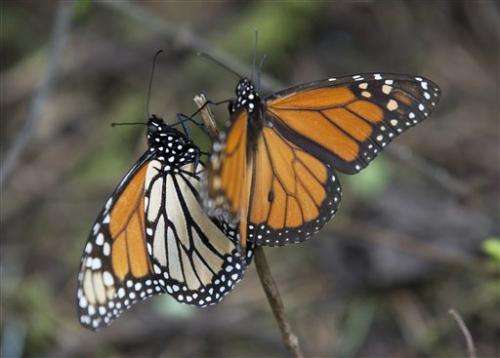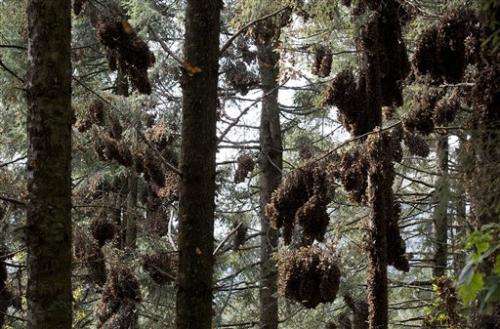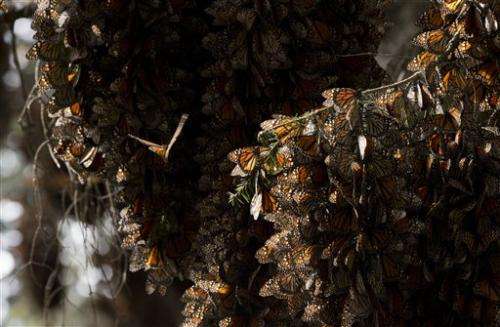Monarch butterflies rebound in Mexico, numbers still low

The number of Monarch butterflies that reached wintering grounds in Mexico has rebounded 69 percent from last year's lowest-on-record levels, but their numbers remain very low, according to the World Wildlife Fund.
Last year, the Monarchs covered only 1.65 acres (0.67 hectares), the smallest area since record-keeping began in 1993.
This year, the butterflies rebounded, to cover 2.79 acres (1.13 hectares), according to a formal census by Mexican environmental authorities and scientists released Tuesday.
The orange-and-black butterflies are suffering from loss of milkweed habitat in the United States, illegal logging in Mexico and climate change. Each year, the butterflies make a migration from Canada to Mexico and find the same pine and fir forests to spend the winter, even though no butterfly lives to make the round trip.
"Of course it is good news that the forest area occupied by Monarchs this season increased," said Omar Vidal, head of the World Wildlife Fund in Mexico. "But let's be crystal clear, 1.13 hectares is very, very low, and it is still the second-smallest forest surface occupied by this butterfly in 22 years of monitoring."
At their peak in 1996, the Monarchs covered more than 44.5 acres (18 hectares) in the mountains west of Mexico City.

Lincoln Brower, a leading entomologist at Sweet Briar College in Virginia, has said that with anything below 2 hectares (4.1 acres), "they will remain in the danger category and I will continue to be concerned. " A population covering 4 or 5 hectares (9 to 12 acres) would be a sign of significant recovery, he added.
The butterfly population has plummeted before, and then partially recovered.
In 2001, driving rain and bitter cold killed millions, leading scientists to speculate that migrating populations would be seriously depleted in 2002. To their surprise, twice as many returned as some had predicted.
In 2004, unfavorable weather, pollution and deforestation caused a drastic decline in the population, but the next year, the butterflies bounced back.
But the overall tendency since 1993 points to a steep, progressive decline. Each time the Monarchs rebound, they do so at lower levels. The species is found in many countries and is not in danger of extinction, but experts fear the migration could be disrupted if very few butterflies make the trip.

The temperate climate of the mountains west of Mexico City normally creates an ideal setting for the Monarchs. Every fall, tens of millions of the delicate creatures fly thousands of miles to their ancestral breeding grounds, creating clouds of butterflies. They clump together on trees, forming chandelier shapes of orange and black.
The migration is an inherited trait: No butterfly lives to make the full round trip, and it is unclear how they find the route back to the same patch of forest each year. Some scientists suggest the butterflies may release chemicals marking the migratory path and fear that if their numbers fall too low, the chemical traces will not be strong enough for others to follow.
Extreme cold and drought also hurt butterfly populations, and in Mexico, illegal logging can punch holes in the forest canopy that shelters them, creating a situation in which cold rainfall could kill millions.
Vidal said Mexico has been able to essentially stop illegal logging in the Monarch protected reserve, but he said habitat loss in the United States remains a huge problem. Milkweed, the butterflies' main source of food has been crowded out by pesticide-resistant crops.
"The question we should all be asking now" is whether the U.S. can halt the loss of milkweed habitat, he said.
© 2015 The Associated Press. All rights reserved.















